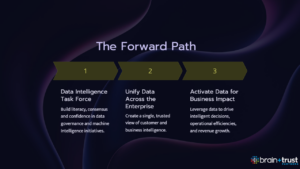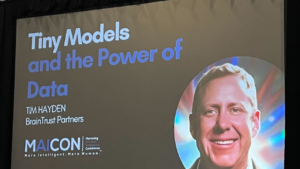with special thanks to my co-author, David Pierpont

Media spending typically represents the largest percentage of a marketing budget and brands rightfully ask their agencies to show results – ROI, ROAS, attribution and more. But before you ask your agency…
- What should my budget be?
- Are you skilled at performance media?
- How can I be more targeted with my media?
- How do you prove what’s working and what’s not?
… make sure your brand has done their part to enable attribution and the discovery of insights. Here are the three musts for a brand to build an impactful, modern media partnership.
1. Invest in Data Infrastructure
Every type of media is most efficient and effective when it leverages clean, structured first-party data. Onboard a Consumer Data Platform (CDP) to capture, unify and deduplicate information from all of your brand’s data sources. A CDP captures and makes sense of:
- Customer events: Online browsing activity, actions on a website or in an app, engagement with an ad unit, in-store visits, webinar attendance and more
- Transactional data: Data related to purchases, returns, POS terminal details, location and more
- Customer attributes: Age, gender, birthday, segmentation data, customer behaviors and predictive analytics and more
- Campaign evaluation data: Impressions, clicks, reach, opens, form fills, engagement, likes, shares, views and more
- Customer-company history: Purchase timeline and history, data from interactions with customer care, NPS scores, CSAT scores, data from chatbots and more
- Additional data sets: Survey results, IoT data, e-commerce data, weather and more
This data can be used to influence product development, streamline operations and bring you into compliance with consumer data privacy laws, but importantly for marketers, it makes media investments sing. With a CDP there is no need to rely only on platforms like Facebook and Google to build Look-Alike (LAL) models. Instead you hold the power to create your own LAL segments, to personalize messaging to your best customers, to reactivate customers who fall into attrition segments and to speak to those more likely to try new products based on their purchase behaviors. With a CDP, your organization has far more control.
As you shop, avoid platforms that leave data gaps. Many that claim to be a CDP are really just data lakes and can’t aggregate all of a brand’s data, nor derive the most meaningful insights. The best CDP platforms ensure that the results of media investments are consistently aligned with customer care data, engagement behavior and sales data, driving accurate ROI and ROAS analyses. As we move to a cookie-less marketing world and see myriad changes to privacy laws, this step is critical to a future-ready media position.
2. Be Honest About Lead Management
Most brands have some type of operational shortcoming as it relates to lead management. It’s not a knock on leadership, or sales, rather it’s the reality of an ever-changing function. When media investors bring leads to your brand, those leads must be nurtured responsibly or the media investment was a waste of time and money for all involved.
To optimize lead management, run a health check on your funnel, both internally and externally, once a quarter. Identify opportunities to streamline processes and reduce friction. Avoid jumping to the conclusion that every issue is due to ‘bad leads’, as that’s often a crutch used to avoid addressing more complex issues. Work alongside your Data and Media agency partners to add elements to your leads management health check over time and consistently develop new ways to test opportunities to improve the quality of leads and targeting for stronger close rates, revenue and scale. Application of data science is helpful in the process. Additional lead management health check tips:
- Use one or two questions in an initial form to improve lead quality, as too many questions can turn off a prospect at this stage.
- When using in-platform lead ads, like in Facebook, run a lead form intent level test to see if qualification questions can be helpful. This test can improve submissions from auto-populated fields (less qualified leads), show if the potential customer is ready to buy (more qualified) and identify those that want more information (still in consideration phase). Each test impacts how the form gets submitted to your leads management tool and more accurately quantifies the perceived “quality” of the lead.
- Leverage additional form qualification questions when appropriate, such as timing of purchase (ASAP, 1-2 weeks, etc.), requests for more information (Yes/No) and even multiple choice questions on the service/product (Front Wheel Drive or AWD? Which rooms need new flooring? Select all that Apply…).
3. Give Back
While an agency doesn’t need full access to your corporate data, they must have a thorough understanding of what happens beyond the click. Sales data is critical, yes, but online and offline consumer behaviors all factor into attribution. An agency cannot provide sophisticated, efficient, optimized solutions if they can’t see the full picture.
Empower agencies by aligning on which metrics are relevant and appropriate to share and how the agency will access the information. Pulling reports is time consuming and often burdensome, so seek solutions where the agency can have a seat with the appropriate view into your data platform(s) and find ways to automate the reporting process to decrease requests. Discuss opportunities to optimize analytics at least once a quarter and hold sessions at least twice a year with a diverse group of constituents, both internal and external, to ideate process improvement. Security, legal compliance and consumer data privacy should be discussed at each session.
In Sum
The media ecosystem can be overwhelming and a consistent pain point for marketers, but as we head into 2021, we can do so with confidence and optimism. We understand that the tech stack, process and people we have in place will determine our success and that brand-agency relationships are changing, which is more than ok. Some brands will build internal teams, some move to a hybrid internal+agency model. Others will continue to rely exclusively on agencies for media services. Whatever your relationship with an outside partner looks like, be sure to remember that all good relationships have give and take. Put your agencies to the test when it comes to collaboration, organization, innovation and efficiency and apply those same measures to your team as well. Your bottom line will show that the work has been done.






